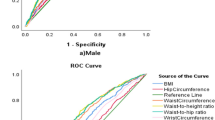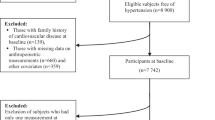Abstract
The aim of the study was to determine the cut-offs of anthropometric markers for detecting hypertension in an endogamous North Indian population. A cross-sectional study was carried out to collect data from 578 adult Aggarwal Baniya subjects (271 men and 307 women, mean age: 43.4 ± 5.3 and 38.7 ± 4.9 respectively) using multistage, stratified sampling method. Individual body weight, height, waist circumference (WC), hip circumference, blood pressure were assessed. Receiver operating characteristic (ROC) analysis was used to find out the optimal cut-off values of various anthropometric markers to predict hypertension. The likelihood ratios for having hypertension in subjects with various cut-off values were calculated. Logistic regression analysis was used to examine the independent relationship between the anthropometric markers and odds of having hypertension. The BMI cut-off to predict hypertension was 22.8 kg/m2 in men and 28.8 kg/m2 in women. The optimal WC cut-offs varied from 91–92 cm in both men and women. The WHR cut-off was about 0.90 in men and 0.78 in women respectively, and the optimal WHtR cut-off was 0.56 in men and 0.43 in women. The cut-off levels for BMI, WC and WHtR corresponded to the inflexion points in the likelihood ratio graphs. The area under curve (AUC) and odds ratios showed that the risk of having hypertension was highest with respect to increased BMI and that BMI is the best predictor of having hypertension. The cut-off points for detecting cardiovascular risk factors among our population are lower than the criteria by the World Health Organization. Although these results may not be readily applied to the rest of the Indian populations due to the multiethnic composition, they point to the necessity of similar studies with large randomized samples to find the cut-off levels for chronic conditions in different populations.


Similar content being viewed by others
References
World Health Organization. (1998). Obesity: Preventing and managing the global epidemic. Report of a WHO consultation of obesity, 3–5 June. WHO: Geneva.
Calle, E. E., Thun, M. J., Petrelli, J. M., Rodriguez, C., & Heath, C. W. (1999). Body-mass index and mortality in a prospective cohort of US adults. New England Journal of Medicine, 341, 1097–1105.
Mora, S., Yanek, L. R., Moy, T. F., Fallin, M. D., Becker, L. C., & Becker, D. M. (2005). Interaction of body-mass index and Framingham risk score in predicting incident coronary disease in families. Circulation, 111, 1871–1876.
WHO Expert Consultation. (2004). Appropriate body-mass Index for Asian populations and its implications for policy and intervention strategies. Lancet, 363, 157–163.
Deurenberg-Yap, M., & Deurenberg, P. (2003). Is a reevaluation of WHO body mass index cut-off values need? The case of Asians in Singapore. Nutrition Reviews, 61, S80–S87.
McNeely, M. J., & Boyko, E. J. (2004). Type 2 diabetes prevalence in Asian Americans. Diabetes Care, 27, 66–69.
WHO/IASO/IOTF. (2000). The Asia-Pacific perspective: Redefining obesity and its treatment. Melbourne: Health Communications Australia.
Steven, J. (2003). Ethnic-specific cut-points for obesity vs country-specific guidelines for action. International Journal of Obesity and Related Metabolic Disorders, 27, 287–288.
Swets, J. A. (1973). The relative operating characteristics in psychology. Science, 182, 990–1000.
Metz, C. E. (1978). Basic principles of ROC analysis. Seminars in Nuclears Medicine, 8, 283–298.
Van der Schouw, Y. T., Verbeek, A. L. M., & Ruijs, J. H. J. (1992). ROC curves for the initial assessment of new diagnostic tests. Family Practice, 9, 506–511.
Simel, D. L., Samsa, G. P., & Matchar, D. B. (1991). Likelihood ratios with confidence: Sample size estimation for diagnostic test studies. Journal of Clinical Epidemiology, 44, 763–770.
Gallagher, D., Visser, M., Sepulveda, D., Pierson, R. N., Harris, T., & Hemysfield, S. B. (1996). How useful is body mass index for comparison of body fatness across age, sex and ethnic groups? American Journal of Epidemiology, 143, 228–239.
Kopelman, P. G. (2000). Obesity as a medical problem. Nature, 404, 635–643.
Ko, G. T. C., Chan, J. C. N., Cockram, C. S., & Woo, J. (1999). Prediction of hypertension, diabetes, dyslipidemia or albuminuria using simple anthropometric indexes in Hong Kong Chinese. International Journal of Obesity and Related Metabolic Disorders, 23, 1136–1142.
Moon, O. R., Kim, N. S., Jang, S. M., Yoon, T. H., & Kim, S. O. (2002). The relationship between body mass index and the prevalence of obesity-related diseases based on 1995 National Health Interview Survey in Korea. Obesity Review, 3, 191–196.
Deurenberg-Yap, M., Chew, S. K., Lin, V. F., Tan, B. Y., van Staveren, W. A., & Deurenberg, P. (2001). Relationships between indices of obesity and its comorbidities in multi-ethnic Singapore. International Journal of Obesity and Related Metabolic Disorders, 25, 1554–1562.
Ito, H., Nakasuga, K., Ohshima, A., Maruyama, T., Kaji, Y., Harada, M., et al. (2003). Detection of cardiovascular risk factors by indices of obesity obtained from anthropometry and dual-energy X-ray absorptiometry in Japanese individuals. International Journal of Obesity and Related Metabolic Disorders, 27, 232–237.
Lin, W. Y., Lee, L. T., Chen, C. Y., Lo, H., Hsia, H. H., Liu, I. L., et al. (2002). Optimal cut-off values for obesity: Using simple anthropometric indices to predict cardiovascular risk factors in Taiwan. International Journal of Obesity and Related Metabolic Disorders, 26, 1232–1238.
Kannel, W. B. (2000). Risk stratification in hypertension: New insight from the Framingham study. American Journal of Hypertension, 13, 3S–10S.
Dı′az, M. E. (2002). Hypertension and obesity. Journal of Human Hypertension, 16, S18–S22.
Dalton, M., Cameron, A. J., Zimmet, P. Z., et al. (2003). Waist circumference, waist–hip ratio and body mass index and their correlation with cardiovascular disease risk factors in Australian adults. Journal of Internal Medicine, 254, 555–563.
Ferguson, T. S., Younger, N. O., Tulloch-Reid, M. K., et al. (2008). Prevalence of prehypertension and its relationship to risk factors for cardiovascular disease in Jamaica: Analysis from a cross-sectional survey. BMC Cardiovascular Disorders, 8, 20.
Gupta, S., & Kapoor, S. (2010). Sex differences in blood pressure levels and its association With obesity indices: Who is at greater risk. Ethnicity and Disease, 2010(20), 370–375.
Rissanen, P., Hamalainen, P., Vanninen, E., Tenhunen-Eskelinen, M., & Uusitupa, M. (1997). Relationship of metabolic variables to abdominal adiposity measures by different anthropometric measurements and dual-energy X-ray absorptiometry in obese middle-aged women. International Journal of Obesity and Related Metabolic Disorders, 21, 367–371.
Han, T. S., Van Leer, E. M., Seidell, J. C., & Lean, M. E. J. (1995). Waist circumference action levels in the identification of cardiovascular risk factors: Prevalence study in a random sample. British Medical Journal, 311, 1401–1405.
Lean, M. E. J., Han, T. S., & Morrison, C. E. (1995). Waist circumference as a measure for indicating need for weight management. British Medical Journal, 311, 158–161.
Deurenberg, P., Yap, M., & Van Staveren, W. A. (1988). Body mass index and percent body fat: A meta-analysis among different ethnic groups. International Journal of Obesity and Related Metabolic Disorders, 22, 1164–1171.
Pi-Sunyer, X. (1991). Health implications of obesity. American Journal of Clinical Nutrition, 53, 1595s–1603s.
Zaher, Z. M., Zambari, R., Pheng, C. S., et al. (2009). Optimal cut-off levels to define obesity: Body mass index and waist circumference, and their relationship to cardiovascular disease, dyslipidaemia, hypertension and diabetes in Malaysia. Asia Pacific Journal of Clinical Nutrition, 18, 209–216.
Nguyen, T. T., Adair, L. S., Suchindran, C. M., He, K., & Popkin, B. M. (2009). The association between body mass index and hypertension is different between East and Southeast Asians. American Journal of Clinical Nutrition, 89, 1905–1912.
Rosenfalck, A. M., Almdal, T., Gotfredsen, A., & Hilsted, J. (1996). Body composition in normal subjects: Relation to lipid and glucose variables. International Journal of Obesity and Related Metabolic Disorders, 20, 1006–1013.
Ko, G. T. C., Chan, J. C. N., Woo, J., et al. (1997). Simple anthropometric indexes and cardiovascular risk factors in Chinese. International Journal of Obesity and Related Metabolic Disorders, 21, 995–1001.
Wu, C. H., Yao, W. J., Lu, F. H., Wu, J. S., & Chang, C. J. (1998). Relationship between glycosylated hemoglobin, blood pressure, serum lipid profiles and body fat distribution in healthy Chinese. Atherosclerosis, 137, 157–165.
Acknowledgments
The financial assistance to SG from Indian Council of Medical Research (ICMR) is gratefully acknowledged. We extend our gratitude to all our participant without whom cooperation this data could not have been known. We also acknowledge the support of Department of Anthropology, University of Delhi, India for providing us the infrastructure for conducting our study.
Conflict of interest
No conflict of interest was declared.
Author information
Authors and Affiliations
Corresponding author
Rights and permissions
About this article
Cite this article
Gupta, S., Kapoor, S. Optimal Cut-Off Values of Anthropometric Markers to Predict Hypertension in North Indian Population. J Community Health 37, 441–447 (2012). https://doi.org/10.1007/s10900-011-9461-8
Published:
Issue Date:
DOI: https://doi.org/10.1007/s10900-011-9461-8




